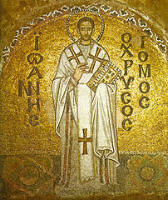
The Divine Liturgies Of Our Fathers by Saint John Chrysostom
A CONCISE EXPLANATION
As to which is the right side of the holy Bread; in what positions we are accustomed to place, the holy Chalice, the Seal of the Theotokos, and the remaining nine Portions of the Saints; and why we place nine, and not more, or less; and lastly which is the right side of the holy Table.
Unutterable, indeed, and incomprehensible is the Mystery of the terrible and sacred celebration, even to the highest powers themselves; for upon the true all-uncorrupt Body of our Lord, as it is seated on its heavenly and proper throne, do they, for trembling and fear veiling themselves with their wings, attend: this same is every day upon earth beheld by us earth-born ones in the celebration. Now seeing then that Jesus, who in this celebration is both priest and victim, for the unsurpassable love which he ever continueth to have for man, hath been pleased to become man, and hath in all things, except sin, partaken of our nature (the manner of his Divine condescension is ineffable), becoming perfect man; and for us did suffer in the flesh, not in the Deity; and as a sheep to slaughter was he led, and as a blameless lamb before his shearer was dumb; and having been received up from us into the heaven, after he had suffered, and was risen again, hath promised to be with us until the end of the world, intending to be every day a bodily victim in the sacred celebration; therefore that we should also signify by words what is done in relation to him in the celebration, he, as Son and Word of his invisible Father, hath of his exceeding goodness commanded us, bestowing upon us wisdom and understanding. So then taking courage in him, we, as far as is possible, explain what appertaineth to him, beginning thus.
That is called the right side of the holy Bread, where the holy Chalice is not placed: for assuredly in the holy Prothesis the Priest, in sacrificially cutting the Bread, representeth the Crucifying of our Lord Jesus Christ, who, of his exceeding longsuffering and condescension, had not the Cross before, but behind his all-holy Body; which Cross the Priest maketh with the holy Lance, saying: When thou wast crucified, O Christ; and this is to be understood as truly the Cross of Christ. But the other, which is seen on the outside, is not made to represent the Crucifixion of the Lord, but for honour only, and distinction of this Bread which is to be hallowed. Therefore also it is imprinted of the bread-makers by the impression of a wooden stamp, before the bread is baked; who contribute nothing to the accomplishment of the Mystery. Wherefore the upper portion of the bread, that hath the Cross, which is made of the bread-makers is the front of the all-holy Body of Christ; but the other, that hath the Cross which the Priest hath made with the Lance, is the back. These things being thus defined, it is manifest, that the side where the holy Chalice is not placed, is the right side of the holy Bread; but the other, where the holy Chalice is placed, is the left. And on the right side we place the portion of our All-holy Lady (on which side also we make the piercing), according to the Prophet that said: There stood by on thy right hand the Queen. But on the left, we place the remaining portions of the Saints; which we make not more, or less, than nine, in imitation of the heavenly Ranks. For as there, according to Dionysius the Areopagite, mighty in Theology, the whole army of these is divided into nine ranks, so here also things that have a peculiar relation to God; for it is the same Jesus that continueth in both. Moreover into three rows, that, as he again, in his sixth, seventh, and eighth Chapters concerning the heavenly Hierarchy, divideth all the heavenly Hierarchies into three triple companies, there might in their complete order be an entire resemblance. From all these things therefore it is manifest, that the right side of the holy Table, as also of the holy Bread, is that in which is placed the portion of our All-holy Lady, and this is indisputable.
Copyright ©1999-2023 Wildfire Fellowship, Inc all rights reserved

 Keep Site Running
Keep Site Running